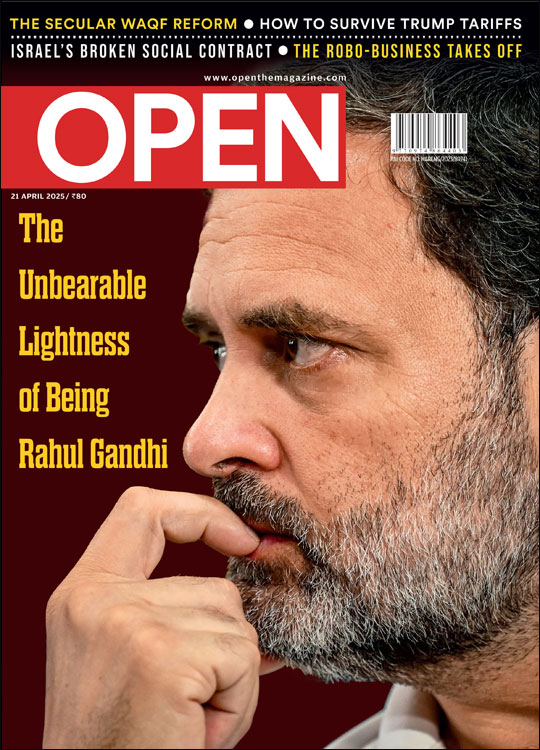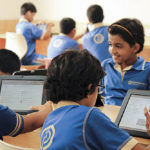TEENS, SEX AND TECHNOLOGY
Social media apps make romance easier for India’s high-schoolers, posing a culture shock to parents
 Aekta Kapoor
Aekta Kapoor
 Aekta Kapoor
|
06 Nov, 2014
Aekta Kapoor
|
06 Nov, 2014
/wp-content/uploads/2015/11/Teensex.jpg)
Social media apps make romance easier for India’s high-schoolers, posing a culture shock to parents
Mehak and Ishaan met on Instagram, when, following the hashtag #happy, Ishaan came upon Mehak’s selfie of herself wearing a white and black striped T-shirt, with a sleepy pout on her face. He left a generous comment—‘Cute’—which set her all aflutter. They had a mutual ‘follower’ they were both vaguely acquainted with and so they began to follow one another too without qualms, clicking on the heart symbol to ‘like’ each other’s photos. This went on almost daily for over a year.
It turned out that Mehak, 15, and Ishaan, 17, were both based in Delhi just a few kilometres apart, though they went to different schools. With Instagram providing a daily chronicle of each other’s lives, they felt close enough to initiate a Kik chat and then a WhatsApp conversation a year later. (“WhatsApp is about giving your mobile number, which is not something I’d do with any random stranger, duh?” says Mehak, using an expression best described as condescending when asked to explain the difference between the two chat apps.) In a few months, by when Ishaan was old enough to drive, the teenagers progressed to Facebook, thus crossing another frontier of intimacy, sharing their daily lives, families and opinions with one another. This led to phone calls and, finally, to their first meeting in person when Ishaan drove his Maruti Wagon R, picked Mehak from the main road a few discreet steps away from her south Delhi home, and went with her to a coffee shop in a mall.
They fell in love, and other apps fed the flame: Snapchat, by which they could send messages and videos that would self-destruct after a preset length of time; Hike, which let them ‘hide’ messages from their folks; Twitter, on which they followed one another’s parents out of general curiosity; Viber, to make phone calls late into the night without a corresponding rise in phone bills; and Skype, for video chats when they went on family holidays where the usual phone roaming didn’t work. They continued to meet once a month in public places, going as far as “second base” in the privacy of Ishaan’s car.
The modern-day fairy tale fell apart when Mehak entered class 12. By then, the pressure of studies (for her) combined with newfound college freedom that brought with it prettier shores (for him) led to bitter quarrels, insecurity and heartache. They officially broke up through WhatsApp (“Why would anyone want to break up on the phone?” asks Mehak), and deleted each other from Facebook but were forced to be part of each other’s lives through other apps that did not allow such clean breaks. They could not, in Toni Braxton’s words, ‘un-break their hearts’. And so they did what any normal teenager would do: they promptly fell in love with someone else, and flaunted their new and improved partners on Instagram, passionately hoping their ex would notice.
“Technology has made romance harder, not easier, for teens,” says Sujata Chatterjee, a Delhi-based clinical psychologist who has worked with Mehak in the past. “A lot of the qualities of the interaction are often imagined, especially when people meet online and not in person. Often our deepest needs are searched for and found in the image of the person we create for ourselves. When that is not confirmed in reality, there are a lot of disappointments to survive.” She points out that recent decades have seen an earlier onset of puberty (now at the age of 8–12 for girls and 10–13 for boys), but stable relationships are achieved and marriages happen later and later, leading to an extended adolescence with its tumultuous stretch of love and longing.
“With smartphone messengers that allow you to see when the other person has read your message and gauge the rate of response, these teens are on tenterhooks all the time. There’s no intuitive ‘knowing in your heart’ that comes from face-to-face boy-girl contact that people would have to wait for… Today, the waiting of minutes is just unbearable. It’s a huge burden on the relationship,” says Chatterjee, adding that educated urban parents are at a crossroads. “Different people respond differently. Some just blame peers if something goes wrong—‘she got into the wrong company,’ they say. But that makes a victim of your child. If you take away choice, you take away responsibility. The key is how you negotiate your way through the needs of the situation as a parent. Blanket bans only drive teen romance undercover—and total permissiveness doesn’t work either; children need to learn to think through a course of action and its consequences while discovering real-life boundaries through their own experiences of hurt and happiness,” she says.
The rules have changed, the battleground has moved, the allies and foes are interchangeable. Conservative values and sex-shy family communication are clashing with overtly sexual media messages wherever you turn, from Bollywood songs to Western TV shows to newspapers. One can forgive today’s urban parents for pulling their hair out in bewilderment at just where to draw the line when it comes to the thorny maze called adolescence. The infamous MMS scandal of over a decade ago—when a class 11 student of Delhi Public School, RK Puram, shared with his buddies a video of his half-naked girlfriend performing oral sex on him, which led to the MMS clip going viral, the boy being expelled, the girl reportedly being ‘exiled’ abroad by her family, and a 2009 Bollywood movie Dev D made of it—only let the cat of teen sex out of the bag, but didn’t bring with it any guidebook on how to deal with it. With the advent of the internet, lusty young hormones have much to get them buzzing. With the coming of the smartphone, the devil is in your pocket. With apps and social media available to all generations and social groups, the average teenager’s parents are damned if they clamp down and damned if they don’t.
Meenakkshi Jaiin, a feng shui consultant who has two daughters, admits to being among a minority of parents who are open-minded when it comes to teen relationships. “I think the present generation of teens is less hypocritical than ours. There are fewer double standards, unlike the older generation who did the same things in secret when they were teenagers themselves,” she observes. When her younger daughter, age 15, had to make a heartbreaking choice in love, Jaiin advised her to relax: “Nothing is the end of life. Go with the decision that feels ‘light’—that’s a good benchmark for every major decision.” She says she would rather make home an open space for her daughters to return to than a prison full of rules. “We talk about sex; they tell me what happens in class, who is having sex and who isn’t. It is all very light-hearted. There’s no stress attached to these discussions. It’s more important for them to make good choices when it comes to friends—that’s where they get the maximum support from.”
She’s right. A study of 78 American middle- school students published in Child Development found that teens who picked healthier partners were mentally and socially healthier a year later. A more extensive 2007 study done jointly by Cornell University, University of Rochester, the New York State Center for School Safety and Cornell Cooperative Extension of New York City found that romantic relationships are central to social life during middle to late adolescence (age 15–19). The study found that three- fourths of American teens, age 16–18, had dated or ‘hooked up’, with over half of these having been in a serious relationship— figures for urban online Indians may not differ too vastly. Most of the youth spent more time with their romantic partners than their family and friends, which in turn played a role in such developmental milestones as forming a sense of identity, refining personal values and interpersonal skills, providing emotional support and achieving self resilience. This was even more significant in the case of sexual minority youngsters compelled by social norms to keep their orientation a secret—their romantic partners were the only people with whom they could feel comfortable and safe sharing thoughts and feelings.
In India, it appears boys face greater stress in relationships. In a study of adolescents in the age group of 16–22 years from Guru Jambheshwar University of Science and Technology, Hisar, Haryana, it was found that boys had higher self-esteem and larger egos than girls, which made them more sensitive to ‘loss of respect’ by others. They also got angrier if their girlfriend did not pay enough attention to them—a possible outcome of old social codes that require girls to be quiet and less expressive about sexuality and deep feelings. Sex education could address some of these problems.
This is something that Lakshmi Kumar, director of Orchid School in Pune, has been working towards. One of the pioneers in implementing the Life Skills Orientation Course in middle school, her school is remarkably progressive in teaching adolescents about sexual choices, consequences and responsibilities, including the hazards of underage pregnancy. “No one talks to them about sex—about power, consent, equality, pleasure, respect. Parents are extremely uncomfortable talking about it, so teens have nowhere else to go but social media, other young adults, peer groups or even porn sites, which give them a completely wrong [impression],” she says.
According to a 2010 National Youth Readership Survey (NYRS) published by National Book Trust India in association with National Council of Applied Economic Research, the internet is accessed by over 35 million urban Indian youth (age 13–35), with about three- fourths of users ‘expressing confidence’ in it as a reliable source of information. It is imperative that schools and educationists step in and demystify sexuality, says Kumar. Though she believes that knowledge of gadgets and social media can be an asset, it can also be a bane if teens aren’t taught the impact and outcome of their online behaviour. “Parents and teens can collaborate beautifully; the teens teach us the grassroots of technology; parents can contribute with the value dimension.”
Kumar rues that teen romance these days appears to have an overwhelming material element, an artificial sense of control, and is often patriarchal with the boy expected to pick up the cheque, drive the girl around and even decide what she wears. The boundaries between romance and sex, between feelings and experimentation, have blurred, she adds. Parents would once be scandalised when their ninth-grade kids came home and said they’d learnt about condoms in school. “We can’t assume these kids will have sex only after marriage. We have to equip them in emotional, social, cultural and physiological ways for every possibility,” says Kumar, who had to hold orientation sessions for parents to explain what the school was up to. “They were relieved but also embarrassed. It was a heavy silence zone.”
Oorja Gonepavaram, a class 10 student in Kumar’s Pune school who admits she is “hopeless at romance”, says that Tumblr and 9gag are still the most common websites used by the kids in her class—all very innocent when compared with high-school kids in Delhi and Mumbai. “Facebook totally disrupts studies, and we’re slightly afraid of WhatsApp because it reveals our profiles. Our school has taught us all about online privacy and cyberbullying,” she says. According to her, there are two kinds of students: those who are in a relationship and those who are desperate to be in one. And most of their parents don’t know. “It’s not love. It’s a status symbol. If a girl has a boyfriend, other boys will be afraid to approach her. And having a girlfriend helps boys keep creepy girls away— there’s nothing worse for a boy’s reputation than having a creepy girl fan,” she adds, sagely. Her words echo the findings of a paper called ‘Early, middle, and late adolescents’ views on dating and factors influencing partner selection’, by Roscoe, Diana and Brooks, which reports that teen relationships are highly egocentric, and are motivated by immediate gratification, recreation and status attainment.
For urban, English-educated Indian youth, there’s another problem: the popularity of American TV shows. Parenting expert and the Ahmedabad- based author of Roots and Wings, Raksha Bharadia found paradoxical worlds while sifting through thousands of entries for two books for the Chicken Soup series on Indian teenagers that she edited. “There’s this big physical world of Indian traditions and rituals that these kids inhabit, and then there’s the world of social media and TV shows such as The Big Bang Theory, Two and a Half Men, Gossip Girls and Two Broke Girls, all of which influence their attitudes towards relationships and sexuality. But it’s not our world, and so there’s this whole lot of guilt and confusion,” she says.
The teens in Bharadia’s books relate stories of the enormous amounts of peer pressure to be in a relationship, drink alcohol, explore drugs, have sex, and of an overarching need for secrecy. “What these kids need is intervention from a neutral source; otherwise, television is messing them up. They demand the independence of the Western youth they see on screen, but not their responsibilities (such as earning their way through college). They want the benefits and comforts of Indian social structures as well,” says Bharadia, who is a mother of two teenage daughters herself.
It is a typical problem that also confronts Dr Kushal Jain, senior consultant psychologist at VIMHANS hospital, Delhi, who finds that technology has boosted both availability and impulsivity in teen romance while adding a dimension of information overload without enough time to process the pros and cons. Tech-savvy teenagers—many of whom are now having sex as early as 13—base their infatuation on text messages and ‘pro-pics’ (profile photos), not on knowledge of past actions, facial expressions, body language and the sheer effort of old- world romance, such as exchanging poetic letters in one’s own handwriting. “This generation makes and breaks relationships very quickly. It’s like two- minute noodles,” says Dr Jain, adding that the issue has a clear class divide, with affluent parents far more accepting of teen romance than those who live in relatively conservative social setups. Having met plenty of kids who break down, get into drug use or attempt suicide, he isn’t a big fan of technology and social media. “I think it has only made things worse. Relationships are shallower. There’s tremendous pressure to update your status at all times, to project a certain image of yourself. Everyone is a celebrity online; it creates a false sense of self- importance,” he says. But parental silence isn’t helping either. “Mothers sometimes talk to daughters, but boys are a neglected lot. Their knowledge of sex and romance is completely based on hearsay and other unsuitable sources.”
A part of the problem is being tackled by groups such as the Centre for Children in Internet and Technology Distress, an internet de-addiction centre launched by a non-governmental organisation called Uday Foundation this July. Helping adolescents regain self-control over computer use and encouraging them to play other indoor and outdoor games, the Centre organises weekends for children and their parents filled with group activities like yoga, meditation, games and storytelling. Kids are advised to use landlines instead of mobile phones, make calls instead of texting, switch off gadgets by 7 pm, and avoid social media and gaming while downloading homework.
Family-taught values, however, remain the key to healthy teenage relationships and the balanced use of technology. Apps and websites that appeal to baser instincts will always be around, but how a child uses them could depend on which way he or she is nudged. Take for example Ask.fm, a Latvia-based website that offers a platform for anyone to ask anonymous questions. It has a user base of over 130 million, people who post millions of questions and answers every day in 49 languages. Hugely popular with Indian teenagers, it is a space for people to meet, criticise, joke, and generally ask questions they cannot in person. A typical question on a teenager’s feed would be ‘Who’s your crush?’ or ‘Would you go out with so-and-so?’ But, as with any other social media tool, Ask.fm has a dark side. An article published in Time this summer told tales of at least seven teenagers who had committed suicide, unable to face the nasty comments left by anonymous acquaintances on the site. Other critics have also sought to blame the website for enabling cyberbullying without questioning the mindset that leads to such behaviour in the first place. “Yes, there is bullying on Ask.fm,” my 15-year-old daughter tells me, “but that happens in the classroom too. You find a way to deal with it and you move on. Those who commit suicide because of something someone said on Ask.fm, or those who bully others on Ask.fm, would do it in any other circumstance too.”
Accepting that we live in difficult times, Raksha Bharadia recommends that parents enlist the support of schools or counsellors to address teen issues related to sex, technology and romance if they aren’t able to bring up the subject themselves.
Lakshmi Kumar agrees. “Just because we are not comfortable talking to our teenagers about it doesn’t mean we can brush these issues away. Instead of prescriptive, the discourse needs to be constructive, designed keeping the learner’s needs in mind,” she says. “It’s time to open the curtain.”
Aekta Kapoor is a Delhi-based writer and a bemused mother of two social media-savvy teenagers she calls her ‘iKids’. Some students’ names in this report have been changed on their request
About The Author
CURRENT ISSUE
The Unbearable Lightness of Being Rahul Gandhi
MOst Popular
3

/wp-content/uploads/2025/04/Cover-Congress.jpg)











More Columns
Finding Ferdinand Kittel Babli Yadav
Ukraine silently encroaches on ‘friendly’ Moldova Ullekh NP
NFRA chief Ajay Pandey joins AIIB Rajeev Deshpande